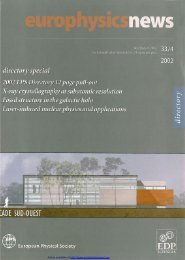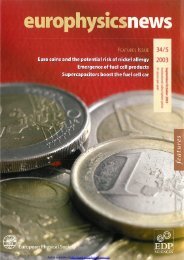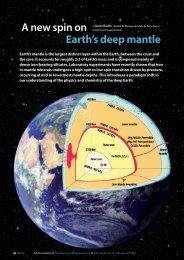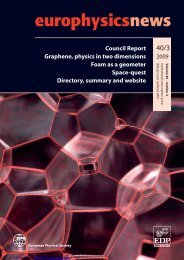Whole issue in PDF - Europhysics News
Whole issue in PDF - Europhysics News
Whole issue in PDF - Europhysics News
You also want an ePaper? Increase the reach of your titles
YUMPU automatically turns print PDFs into web optimized ePapers that Google loves.
FEATURES<br />
Fig. 2: Study of liquid metal<br />
embrittlement by means of high<br />
resolution absorption<br />
tomography. Reconstructed slices<br />
of a polycrystall<strong>in</strong>e alum<strong>in</strong>ium<br />
alloy: a) <strong>in</strong> its <strong>in</strong>itial state b) after<br />
exposure for 4 hours to liquid<br />
gallium close to room temperature<br />
c) after a supplementary anneal<br />
for two hours at 300·C. The<br />
gallium appears <strong>in</strong> b) as white<br />
l<strong>in</strong>es at the gra<strong>in</strong> boundaries.<br />
These l<strong>in</strong>es become diffuse <strong>in</strong> c) as<br />
gallium diffuses <strong>in</strong>to the<br />
alum<strong>in</strong>ium gra<strong>in</strong>s. The voxel size <strong>in</strong><br />
the images is 1 IJm, correspond<strong>in</strong>g<br />
to a spatial resolution of 1.7 IJm.<br />
scanner or CAT. From the tomographic reconstruction, one can at<br />
will produce cuts orvolume render<strong>in</strong>gs ofthe object. The number<br />
of 2D images required is approximately equal to the number of<br />
pixel columns <strong>in</strong> the detector. At the imag<strong>in</strong>g beaml<strong>in</strong>e ID19, this<br />
number is typically 900 when us<strong>in</strong>g a 1024x1024 pixel CCD camera.<br />
The time required for record<strong>in</strong>g these 2D images with an<br />
extended, parallel and moderately monochromatic (M/E:; 10- 2 )<br />
beam is now less than 10 m<strong>in</strong>utes, while the 3D reconstruction<br />
time, on a powerful computer, rema<strong>in</strong>s on the order of one hour.<br />
The spatial resolution is ma<strong>in</strong>ly determ<strong>in</strong>ed by the detector specially<br />
developed for these experiments. The usual tool is an X-ray<br />
--> visible light converter screen coupled, via visible light optics,<br />
to a cooled CCD camera (FRELON, for Fast REad-out, LOw<br />
Noise) developed at ESRF.<br />
Under specific conditions a liquid metal can penetrate <strong>in</strong>to the<br />
gra<strong>in</strong> boundaries ofa polycrystall<strong>in</strong>e solid metal,lead<strong>in</strong>g to a brittle<br />
behaviour of the normally ductile solid. This phenomenon,<br />
known as liquid metal embrittlement,was discovered more than a<br />
century ago. However, the mechanisms lead<strong>in</strong>g to rapid penetration<br />
along gra<strong>in</strong> boundaries rema<strong>in</strong> poorly understood.<br />
Absorption radiography and tomography, with a spatial resolution<br />
ofabout 1 micron, are well suited to studies on the k<strong>in</strong>etics of<br />
this process <strong>in</strong> the case ofalum<strong>in</strong>ium alloys. Gallium, which is liquid<br />
just above room temperature, attenuates X-rays much more<br />
thanalum<strong>in</strong>ium. This makes it possible to observe <strong>in</strong>-situ the penetration<br />
ofgallium <strong>in</strong>to the bulk. Figure 2 shows the same virtual<br />
slice of an alum<strong>in</strong>ium alloy (AI 5038) at various stages. The first<br />
tomographic image (figure 2a) shows the <strong>in</strong>itial state ofthe sample;<br />
the isolated white po<strong>in</strong>ts correspond to Fe and Mu rich<br />
<strong>in</strong>clusions. Figure 2b was recorded after liquid gallium was<br />
allowed to penetrate, andafter anneal<strong>in</strong>g the sample close to room<br />
temperature: the white l<strong>in</strong>es that divide the sample <strong>in</strong>to cells <strong>in</strong>diresults<br />
recently obta<strong>in</strong>ed, after prelim<strong>in</strong>ary<br />
attempts on pigs, on<br />
human patients at the medical<br />
beaml<strong>in</strong>e ID17 ofthe ESRF.<br />
Absorption microtomography<br />
The three-dimensional (3D) reconstruction of<br />
complex structures, on the basis ofmany images<br />
obta<strong>in</strong>ed for different orientations ofthe sample<br />
with respect to the beam, is possible with spatial<br />
resolution down to 1 /lm (microtomography).<br />
This is the smaller-scale analogue ofthe medical<br />
europhysics news MARCH/APRIL 2001<br />
Imag<strong>in</strong>g through magnetic<br />
dichroism<br />
Ref<strong>in</strong>ement is perhaps even more<br />
obvious <strong>in</strong> the use for imag<strong>in</strong>g of<br />
magnetic X-ray dichroism, which<br />
several groups have developed <strong>in</strong><br />
the "soft" X-ray range (energy<br />
< 1 keV). In a magnetic material, <strong>in</strong> the immediate vic<strong>in</strong>ity of an<br />
absorption edge, absorption can, for a given polarisation state of<br />
the <strong>in</strong>cidentbeam, depend on the magnetisation r-------------------------------,<br />
state of the sample. It is therefore possible to<br />
image the distribution of magnetisation, i.e. the<br />
magnetic doma<strong>in</strong>s, with only one chemical element<br />
at a time be<strong>in</strong>g sensed s<strong>in</strong>ce the energy of<br />
the edge is different for each. This is obviously<br />
attractive <strong>in</strong> the case of magnetic multilayers,<br />
where the magnetisation directions vary from<br />
one layer to the other. Several approaches are<br />
used to change the small variation <strong>in</strong> X-ray<br />
absorption <strong>in</strong>to an image. Some use an electronoptical<br />
system to produce an enlarged picture<br />
through the emitted photoelectrons, which are<br />
the more numerous the higher X-ray absorption<br />
is. These experiments, based on the use of secondary<br />
electrons, and on absorption edges<br />
correspond<strong>in</strong>g to soft X-rays, can only be performed<br />
<strong>in</strong> a good vacuum, and only reveal the<br />
immediate neighbourhood of the surface.<br />
Another approachis the use ofa transmission X<br />
ray microscope, as at BESSY (Berl<strong>in</strong>), which<br />
proved a powerful tool for prob<strong>in</strong>g the magnetisation<br />
process <strong>in</strong> Gd-Fe multilayers.<br />
~.<br />
a<br />
c<br />
Fig. 3: Three-dimensional renditions of<br />
snow samples reconstructed from about<br />
1000 radiographs obta<strong>in</strong>ed at an X-ray<br />
energy of 10 keV. The samples were<br />
ma<strong>in</strong>ta<strong>in</strong>ed at a temperature of -60·C <strong>in</strong><br />
a cryostat dur<strong>in</strong>g the experiment. The<br />
images correspond to volumes of 300 3<br />
voxels with size 10 IJm. a) sample of wet<br />
snow with well-rounded gra<strong>in</strong>s b)<br />
sample with faceted crystals<br />
transformed under the action of a large<br />
temperature gradient (of the order of<br />
1·Clcm) c) melt-freeze crust, partially<br />
faceted under a natural temperature<br />
gradient (courtesy C. Coh!ou).<br />
b<br />
47










